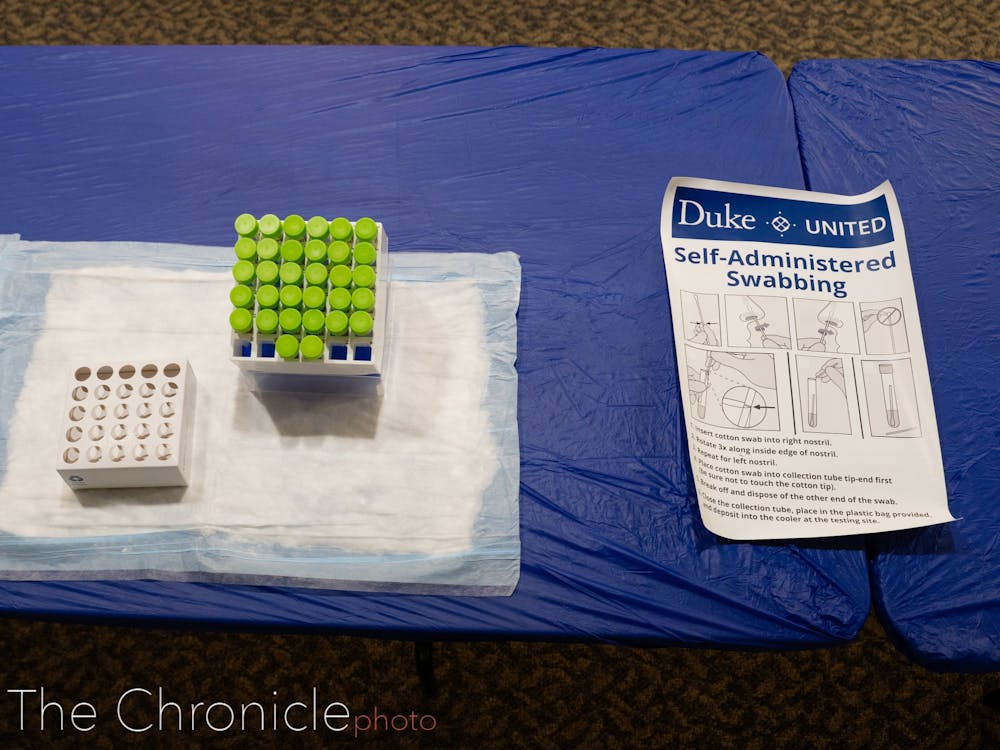Doing a quick nasal swab at a COVID-19 testing site has become routine for many at Duke. But how much is testing and contact tracing costing the University?
Duke conducted more than 15,000 tests in the past two weeks of reported testing data. This includes entry tests for all students; pooled surveillance tests; clinical tests for all faculty, staff and students who report symptoms and are contact traced; the contact tracing program; and infrastructure, wrote Michael Schoenfeld, vice president for public affairs and government relations, in an email
Schoenfeld wrote that the total cost will likely be “several million dollars over the academic year.”
Vice President of Administration Kyle Cavanaugh affirmed in an email that several million dollars “is the most accurate estimate we have at this point.” He added that at the start of the academic year, the University had “rough cost estimates,” and current expenses “are running within those estimates.”
Schoenfeld wrote that Duke’s partnership with the Duke Human Vaccine Institute has allowed the University to keep the costs lower than if it had to use outside vendors.
Thomas Denny, professor of medicine and chief operating officer of the Human Vaccine Institute, wrote in an email that the partnership provided new equipment and supplies, additional staff, and collaboration with the University on logistics regarding testing centers and transportation of samples.
“Since no one has ever done anything like this before it’s impossible to estimate the cost savings, but we do [know] that this process is considerably less expensive than the standard clinical testing process, which is used to confirm positive results from the surveillance tests,” Denny wrote.
Schoenfeld noted that testing makes up only a small part of Duke’s overall annual budget of $2.8 billion. The coronavirus pandemic as a whole has made a much bigger and broader financial impact on the University than the extra expenses from testing and contact tracing, as it has resulted in “reduced revenue in many areas and added expenses that vary widely across the university,” Schoenfeld wrote.
In a May news release, President Vincent Price estimated that Duke’s revenue shortfall due to the pandemic could reach 15% of its annual operating budget—between $250 million and $350 million. To cut costs, Duke has taken steps such as temporarily freezing hiring and suspending its contributions to a retirement plan for faculty and staff.
Price told The Chronicle last month that revenue losses had been “a little bit larger” than predicted but that savings had also been higher than predicted.
The University’s endowment also dipped from last year’s record high of $8.6 billion to $8.5 billion as of June 30, amid stock market volatility due to the pandemic.
Despite this, many class budgets remained the same. Ann Saterbak, professor of the practice in the department of biomedical engineering, who teaches the first-year EGR 101 class, wrote in an email that team budgets are still $250 like in previous years. Foundry Manager Ali Stocks wrote in an email that The Foundry’s budget has also not been affected by any factors related to COVID-19.
Mona Tong contributed reporting.
Get The Chronicle straight to your inbox
Sign up for our weekly newsletter. Cancel at any time.

Katie Tan is a Trinity senior and digital strategy director of The Chronicle's 119th volume. She was previously managing editor for Volume 118.

